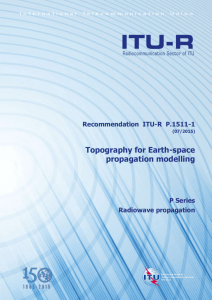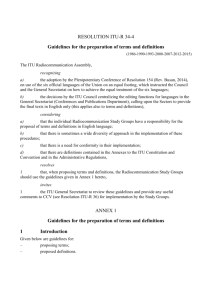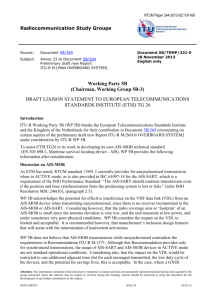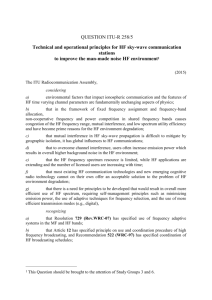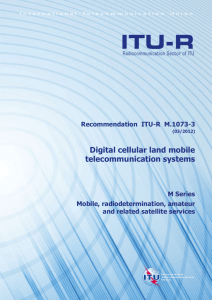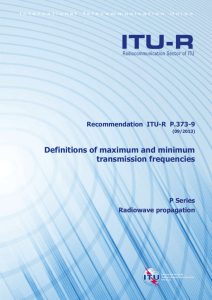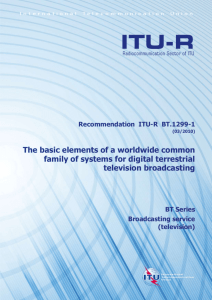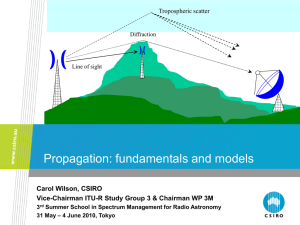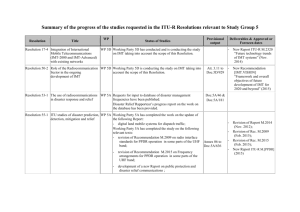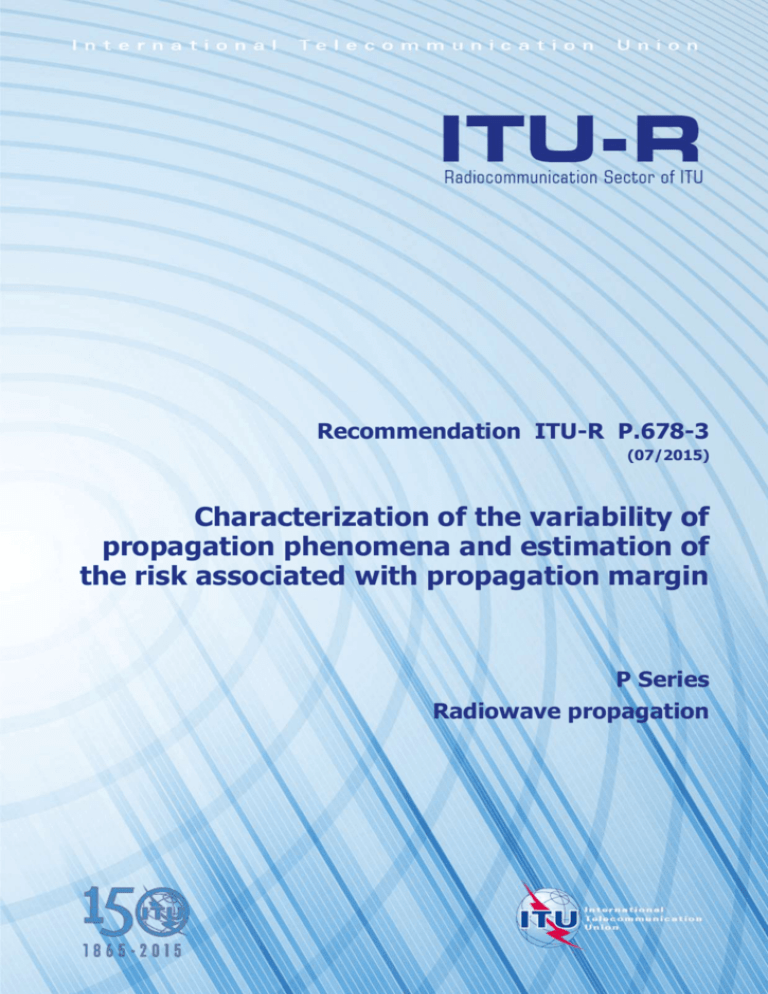
Recommendation ITU-R P.678-3
(07/2015)
Characterization of the variability of
propagation phenomena and estimation of
the risk associated with propagation margin
P Series
Radiowave propagation
ii
Rec. ITU-R P.678-3
Foreword
The role of the Radiocommunication Sector is to ensure the rational, equitable, efficient and economical use of the
radio-frequency spectrum by all radiocommunication services, including satellite services, and carry out studies without
limit of frequency range on the basis of which Recommendations are adopted.
The regulatory and policy functions of the Radiocommunication Sector are performed by World and Regional
Radiocommunication Conferences and Radiocommunication Assemblies supported by Study Groups.
Policy on Intellectual Property Right (IPR)
ITU-R policy on IPR is described in the Common Patent Policy for ITU-T/ITU-R/ISO/IEC referenced in Annex 1 of
Resolution ITU-R 1. Forms to be used for the submission of patent statements and licensing declarations by patent
holders are available from http://www.itu.int/ITU-R/go/patents/en where the Guidelines for Implementation of the
Common Patent Policy for ITU-T/ITU-R/ISO/IEC and the ITU-R patent information database can also be found.
Series of ITU-R Recommendations
(Also available online at http://www.itu.int/publ/R-REC/en)
Series
BO
BR
BS
BT
F
M
P
RA
RS
S
SA
SF
SM
SNG
TF
V
Title
Satellite delivery
Recording for production, archival and play-out; film for television
Broadcasting service (sound)
Broadcasting service (television)
Fixed service
Mobile, radiodetermination, amateur and related satellite services
Radiowave propagation
Radio astronomy
Remote sensing systems
Fixed-satellite service
Space applications and meteorology
Frequency sharing and coordination between fixed-satellite and fixed service systems
Spectrum management
Satellite news gathering
Time signals and frequency standards emissions
Vocabulary and related subjects
Note: This ITU-R Recommendation was approved in English under the procedure detailed in Resolution ITU-R 1.
Electronic Publication
Geneva, 2015
ITU 2015
All rights reserved. No part of this publication may be reproduced, by any means whatsoever, without written permission of ITU.
Rec. ITU-R P.678-3
1
RECOMMENDATION ITU-R P.678-3
Characterization of the variability of propagation phenomena and
estimation of the risk associated with propagation margin
(1990-1992-2013-2015)
Scope
This Recommendation provides three prediction methods of:
–
the expected year-to-year variation of the worst-month time fraction of excess;
–
the inter-annual variability of rainfall rate and rain attenuation statistics;
–
risk parameters associated with the variation of rain attenuation statistics.
The ITU Radiocommunication Assembly,
considering
a)
that knowledge of the variability of propagation phenomena is required to allow proper cost
and performance trade-offs to be made in the analysis of system reliability, availability and quality;
b)
that a prediction procedure to estimate risk parameters associated with the variation of
propagation statistics is required for the formulation of performance criteria of radiocommunication
system;
c)
that a prediction procedure exists for the estimation of the statistics of the year-to-year
variations in the annual worst-month time fraction of excess as defined in Recommendation
ITU-R P.581,
recommends
1
that Fig. 1 of Annex 1 be used for the estimation of the expected year-to-year variation of
the annual worst-month time fraction of excess;
2
that the expected variation about a long-term average predicted value be reported as a
function of return period;
3
that the inter-annual variability of rainfall rate and rain attenuation statistics around a
long-term average statistics be computed from Annex 2;
4
that the risk parameters associated with the variation of propagation statistics be computed
from Annex 3.
NOTE 1 – The return period is the average time interval between two consecutive occurrences of a
defined stochastic event. For a long series of observation, the value of the return period is 1/P
(times the average interval between all pairs of consecutive events) where P is the probability of
occurrence of the event. For example, the median value of a long series of annual worst-month time
fraction of excess values would have a two-year return period.
NOTE 2 – The risk is defined as the probability that the yearly guaranteed availability is not
fulfilled.
2
Rec. ITU-R P.678-3
Annex 1
Estimation of the expected year-to-year variation of the
annual worst-month time fraction of excess
FIGURE 1
Dependance of WR/PW on Q for several value
of the return period R (years)
20
15
R = 50
10
8
20
WR /PW
6
4
10
3
5
2
1
2
1.25
0
3
4
5
6
7
8
9
10
11
12
Q
PW :
WR:
Q:
average annual worst-month time fraction of excess
annual worst-month time fraction of excess associated
with a return period of R years
worst-month quotient, a propagation climatic factor
(see Recommendation ITU-R P.841)
P.0678-01
Note 1 – PW, WR, Q should be referred to the same pre-selected threshold value.
Rec. ITU-R P.678-3
3
Annex 2
Inter-annual variability of rainfall rate and rain attenuation statistics
For a desired location, the inter-annual fluctuations of rainfall rate and rain attenuation statistics
around the long-term Complementary Cumulative Distribution Function (CCDF) p are normally
distributed with mean p and yearly variance ² so that:
2 ( p) C2 ( p) 2E ( p)
(1)
where:
2E :
is the variance of estimation
C2 :
is the inter-annual climatic variance.
The following prediction method provides a step-by-step procedure to compute 2 ( p) associated
with the probability of exceedance p.
The following parameters are required:
p: probability of exceedance (0 ≤ p ≤ 1)
rc: climatic ratio.
The values of rc, the climatic ratio, are an integral part of this Recommendation and are available in
the form of digital maps provided in the file CLIMATIC_RATIO.ZIP.
CLIMATIC_RATIO.ZIP
These maps were derived from 50 years of Global Precipitation Climatology Centre (GPCC) data
over land and from 34 years of Global Precipitation Climatology Project (GPCP) data over the
ocean.
Step 1: For the desired probability of exceedance, p, compute:
C
N 1
cU (it, p)
(2)
i N 1
where:
N 525960
t 60
(3)
b
cU (it , p ) exp( a it )
with:
b b1 ln( p ) b2
a 0.0265 s 1
b1 –0.0396
b2 0.286
Step 2: The variance of estimation 2E is computed from:
(4)
4
Rec. ITU-R P.678-3
2E ( p )
p(1 p )
C
N
(5)
Step 3: Extract the variable rc for the four points closest in latitude (Lat) and longitude (Lon) to the
geographical coordinates of the desired location.
Step 4: From the values of rc at the four grid points, obtain the value rc(Lat, Lon) at the desired
location by performing a bi-linear interpolation, as described in Recommendation ITU-R P.1144.
2
Step 5: The inter-annual climatic variance C is computed such that:
2
C
( p) rc ( Lat, Lon) p 2
(6)
If a predicted, rather than an experimental, CCDF is used, the predicted CCDF will not exactly
match the actual rainfall rate or rain attenuation (e.g. measured CCDF of rain attenuation will not
exactly match the CCDF of rain attenuation predicted by Recommendation ITU-R P.618). In this
case, an additional error, 2M ( p) , must be considered in which case equation (1) becomes:
2 ( p) C2 ( p) 2E ( p) 2M ( p)
(7)
where 2M ( p) is the error in the predicted CCDF. To assess the impact of the variance 2 ( p) , it is
convenient to refer to the 68% confidence interval p ( p), p ( p) that corresponds to plus or
minus one standard deviation around the probability for a normally distributed quantity.
The procedure is applicable for time percentages of exceedance from 2% to 0.01%
(i.e. 0.0001 ≤ p ≤ 0.02) and for the frequency range from 12 to 50 GHz.
Annex 3
Estimation of the risk associated with propagation margin
Given a fixed rain attenuation Ar exceeded for a given probability p ( 0 p 1 ) such as
P( A Ar ) p , the risk (meaning the probability) that the yearly probability p ( 0 p 1 ) is
exceeded satisfies:
p p
Q
( p )
(8)
p ( p)Q 1() p 2( p)erfc1(2) p
(9)
or equivalently:
where ( p ) can be computed from Annex 2 and where (see Recommendation ITU-R P.1057):
Rec. ITU-R P.678-3
Q x
1
2
e
t2
2 dt
x
Importantly, note that p = p in equation (8) leads, as expected, to =0.5.
5



